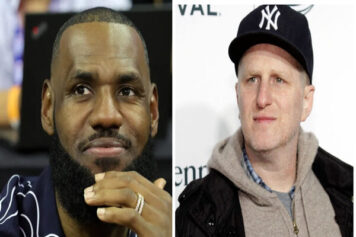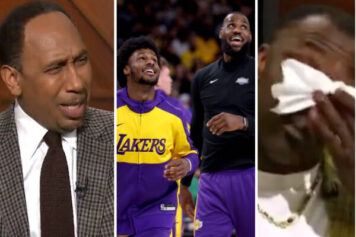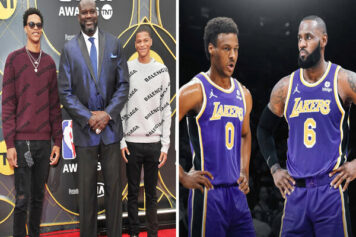Andrew Bynum has exhibited the strength of 100 men.
He’s also been as brittle as a potato chip.
With Bynum, it’s never been a case of talent. His knees experience the same type of fragility and unpredictability as most 7-footers. His personality, especially early in his career, was riddled with immaturity and, according to sources, “Daddy issues," as Bynum’s mom and dad separated when he was a 1-year old.
In the fifth grade, he was the tallest kid and the most uncoordinated. He started to fill his body out by the eighth-grade, and by the time he entered New Jersey's West Windsor-Plainsboro High School North, he was about 7-feet tall, had the size, showed potential, but he was as raw as an Old Dirty Bastard joint.
That was understood, because when LA selected Bynum with the 10th pick of the 2005 NBA Draft at age 17, Bynum, who was 244 days into being 17 at the time, was 12 days younger than Jermaine O'Neal, the previous youngest player drafted. LA hired Hall of Famer Kareem Abdul-Jabbar to work with Bynum, and while he wasn’t Patrick Ewing out of box, he showed flashes of Robert “Chief” Parish, minus the kush.
After a few seasons of development and dealing with the lofty expectations, ball domination, and the “tough love” that Kobe Bryant dishes out, the Lakers rewarded Bynum with a four-year, $58 million contract.
Although Bynum stayed hurt, he was fortunate to be able to develop in LA playing with Bryant, Pau Gasol, and a cast of other dynamic players. Bynum’s game—although inconsistent and injury riddled—blossomed enough to be a serious X-factor and needed contributor to the Lakers’ back-to-back championships.
After sitting out the 2008 Finals loss to the Celtics with busted knees, and feeling somewhat responsible, Bynum averaged 58 games, 14.7 ppg, 8.1 rebounds and daily grit in the following two seasons. He did whatever was needed to crawl out on the court and contribute.
Bynum limped, hobbled, and staggered his way through those postseasons, receiving two hours of treatment on his right knee daily in hopes that he would be able play 30 minutes come game day. In the process, he sacrificed his future to capture the greatest of NBA glories. In the 2008-2009 c’hip season, Bynum suffered a torn MCL in his right knee and missed 32 games. But he still made his mark.
In the Lakers 2009-2010 c’hip season, Bynum tore the meniscus in his right knee in Game 6 against the Oklahoma City Thunder in the first round. It was the third consecutive season his knee injuries impacted the Lakers postseason, however Bynum was credited with being tenacious and playing through it.
"The reason I don't want to miss anything is because I missed the Finals two years ago and we lost and when I played we won and I want to keep that collective energy as a whole there," Bynum said before Game 7 in 2010. He had his best year in 2011-12 averaging 11.8 rebounds and nearly 19 points per battle. Philly tapped him to be its franchise savior, but fragile knees never allowed him to do his thing as a 76er.
With a body that failed The City of Brotherly Love, his heart and soul were blamed. All that’s left now is some bitter taste buds and talk about what could have been, like how Bynum is just another big man similar to Jeff Ruland, Roy Hinson and Matt Geiger. Each set the franchise back years because they couldn't stay on the floor. But back West, despite Bynum’s injuries, he was able to give the Lakers enough to help them reach the promise land.
A big man with his skills is an asset to any team. It's why cats like Greg Oden keep getting picked up in hopes that he can stay healthy long enough to impact a few crucial games in May or June. The older these injury-plagued big men get, the more their health situation becomes a crapshoot. Philly crapped out. They placed their entire franchise’s hopes on unstable bones, but it seems an up-and-coming young Cleveland squad will eventually reap the benefits of acquiring the 2012 NBA All-Star. With Kyrie Irving leading the charge, daily improvement from other youngsters like Dion Waiters, and the pipe dream to get LeBron James to return home as a free agent, all the Cavs need is timely play and leadership from the nine-year vet. And Bynum is looking healthier than he has in a minute.
Saturday, he came through with a vintage performance, playing a season-high 30 minutes in a 97-93 victory over the Chicago Bulls, snapping a five-game Cavs slide. With Irving struggling to carry the load, Bynum stepped up and lifted the young team to victory. He made the go-ahead basket with 3:35 left and had his best all-around game of the season with 20 points, five blocked shots, and 10 rebounds.
''It felt good,'' said Bynum, who earlier in the season was contemplating retirement as he attempts a comeback from surgery on both knees. ''I won't lie to you.''
A 5-12 Cleveland team that experts were picking to make its first playoff appearance since 2010 BKL (before the king left), is struggling to find consistency under Mike Brown. A relatively healthy Bynum could change the season around or at least help the Cavs reach 30-wins for the first time since “The Decision” killed Cleveland.
The previous Saturday, the 294-pound paint punisher had 16 points and six boards in a 126-96 loss at San Antonio. But it was the second night of a back-to back set − something he hadn’t done all season.
Bynum may never get his explosion or athleticism back, but even at 85 percent, he’s considered one of the top 5 centers in the game and adds a low post threat that makes Cleveland more than a guard-dominated crème puff.
"This is who he is,'' Brown said of Bynum, via Mary Schmitt Boyer of The Plain Dealer. "Even if he doesn't get his bounce back, he's so skilled and he's so big and so strong, if he just stays with it once he gets his timing back but, more importantly once we figure out how to play with him, I think good things can happen."
Anything is better than battling Milwaukee (3-12) and the Knicks (3-12) in the Eastern Conference gutter.
“For a guy his size, he was a quick jumper and a multiple jumper,” Brown said in late November. “But as you guys can see, he doesn’t need his explosiveness offensively.“You look at a guy like (Indiana center) Roy Hibbert. Roy is not necessarily a big-time athlete. Andrew is just as skilled if not more skilled than Roy playing the game offensively. Roy is an impact player in this league. Andrew can be an impact player on both ends without getting his explosiveness back because he’s very smart. He’s long. He’s strong. He’s got a lot of intangible things about him that can help get him there.”
Cleveland doesn’t care where “there” is, as long as the direction is going up in the Eastern Conference’s Central Division standings.



